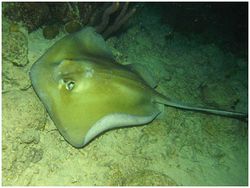شفنينيات
| الشفنين Batoidea | |
|---|---|

| |
| Southern stingray (Dasyatis americana) | |
| التصنيف العلمي | |
| مملكة: | |
| Phylum: | |
| Class: | |
| Subclass: | |
| Superorder: | Batoidea
|
| Orders | |
الشفنين Batoidea، اسم يطلق على أي نوع من المجموعة التي تضم 350 نوعا من السمك، مثل الشفنين النسر، والقيثاري، وشيطان البحر، وأبي منشار، والورنك، والسمك اللساع، والرعاد الكهربائي.
وتعيش معظم أسماك الشفنين في قاع البحار، وتتغذى بالكائنات البحرية الموجودة به مثل المحار والأسماك الرخوية وأنواع معينة أخرى من الأسماك، والكثير من الأنواع يعيش في المياه الساحلية لكن القليل يعيش في الأعماق السحيقة للبحار. فالنوع المسمى شيطان البحر يعيش في المياه العلوية من البحار ويتغذى بالحيوانات البحرية الصغيرة وكائنات بحرية أخرى تسمى العوالق. وأسماك الشفنين تشبه سمك القرش في هيكلها العظمي، وهي لاتتكوّن من عظام، بل من مادة مطاطية مرنة تُسمى الغضاريف. كذلك تشبه أسماك الشفنين سمك القرش في أن لها فتحات في جسمها تُسمى فتحات الخياشيم إلا أن فتحات الخياشيم في سمك الشفنين سفلية تقع تحت الزعانف الصدرية في حين أن الفتحات الخيشومية في سمك القرش تكون على جانبي الرأس. ومعظم أسماك الشفنين مفلطحة الشكل شبيهة بالقرص وتكون الزعانف على هيئة أجنحة كبيرة في معظم الأنواع. أما النوعان المسمَّيان: القيثاري وأبو منشار فلهما شكل يشبه الطوربيد كشكل سمك القرش. ولا يماثل بيض سمك الشفنين بيض معظم الأنواع الأخرى من الأسماك، حيث يخصّب داخل جسم السمكة الأنثى. وتضع أنثى الشفنين بيضها المخصب في أكياس قرنية لحمايته. أمّا بيض أسماك الشفنين الأوروبية شائكة الظهر الذي لا يخصَّب فتجرفه المياه على الشواطئ في أكياس تعرف بأكياس حوريات الماء.
التشريخ
المعيشة
التغذية
التصنيف
|
| |||||||||||||||||||||||||||
| Phylogenetic tree of Batoidea, from McEachran and Aschliman (2004) |
The classification of batoids is currently undergoing revision. Nelson's 2006 Fishes of the World recognizes four orders. The Mesozoic Sclerorhynchoidea are basal or incertae sedis; they show features of the Rajiformes but have shouts resembling those of sawfishes.
Order Torpediniformes
The electric rays have electric organs in their pectoral fin discs that generate electric current. They are used to immobilize prey and for defense. The current is strong enough to stun humans, and the ancient Greeks and Romans used these fish to treat ailments such as headaches.[2]
- Family Narcinidae (numbfishes)
- Family Torpedinidae (torpedo electric rays)
Order Pristiformes
The sawfishes are shark-like in form, having tails used for swimming and smaller pectoral fins than most batoids. The pectoral fins are attached above the gills as in all batoids, giving the fishes a broad-headed appearance. They have long, flat snouts with a row of tooth-like projections on either side. The snouts are up to 1.8 metres (6 ft) long, and 30 centimetres (1 ft) wide, and are used for slashing and impaling small fishes and to probe in the mud for imbedded animals. Sawfishes can enter freshwater rivers and lakes. Some species reach a total length of 6 metres (20 ft).
- Family Pristidae (sawfishes)
Order Rajiformes
- Family Rajidae (skates)
- Family Rhinidae (bowmouth guitarfishes)
- Family Rhinobatidae (guitarfishes)
- Family Rhynchobatidae (wedgefishes)
Order Myliobatiformes
- Family Dasyatidae (whiptail stingrays)
- Family Gymnuridae (butterfly rays)
- Family Hexatrygonidae (sixgill stingrays)
- Family Myliobatidae (eagle rays)
- Family Platyrhinidae (thornbacks)
- Family Plesiobatidae (deepwater stingrays)
- Family Potamotrygonidae (river stingrays)
- Family Urolophidae (round stingrays)
- Family Urotrygonidae (American round stingrays)
- Family Zanobatidae (panrays)
المصادر
- ^ Stevens, J. & Last, P.R. (1998). Paxton, J.R. & Eschmeyer, W.N. (ed.). Encyclopedia of Fishes. San Diego: Academic Press. p. 60. ISBN 0-12-547665-5 begin_of_the_skype_highlighting 0-12-547665-5 end_of_the_skype_highlighting.
{{cite book}}: Check|isbn=value: invalid character (help)CS1 maint: multiple names: authors list (link) - ^ Bullock, Theodore Holmes, Hopkins, Carl D., Popper, Arthur N., and Fay, Richard R. (2005). Electroreception. Springer. pp. 5–7. ISBN 0387231927.
{{cite book}}: CS1 maint: multiple names: authors list (link)
- Batoids: Sawfishes, Guitarfishes, Electric Rays, Skates, and Sting Rays
- www.shark-references.com: Database of bibliography of living/fossil sharks and rays (Chondrichtyes: Selachii) with more than 9.000 listed papers and a lot of downloadlinks
- J. D. McEachran, K. A. Dunn, T. Miyake (1996). "Interrelationships of the batoid fishes (Chondrichthyes: Batoidea)". In Interrelationships of Fishes, Academic Press.